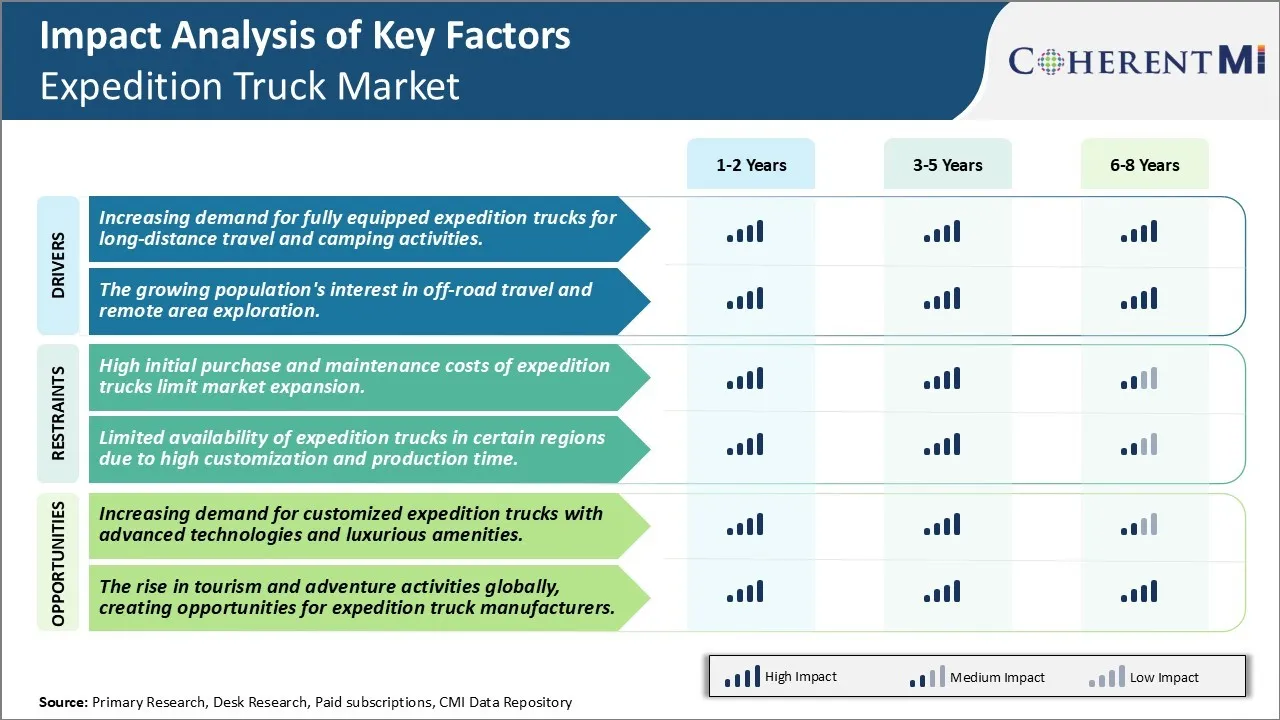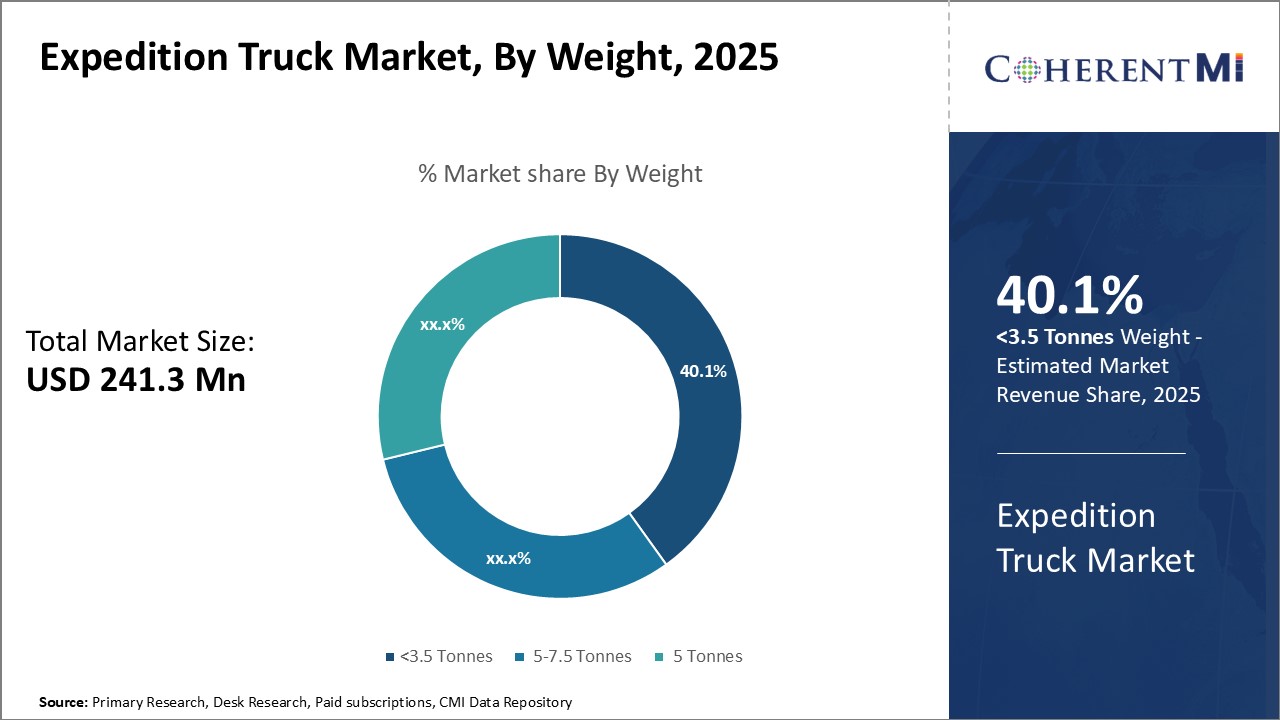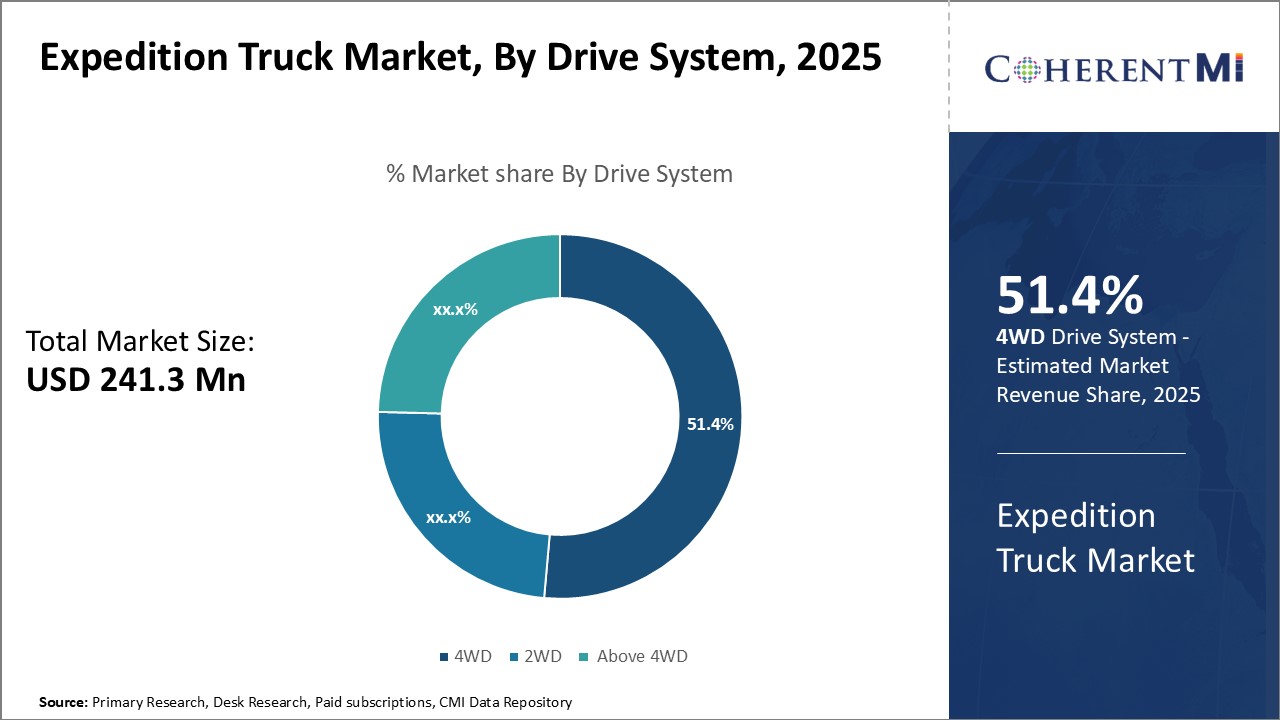Expedition Truck Market Size - Analysis
Market Size in USD Mn
CAGR9.1%
| Study Period | 2025-2032 |
| Base Year of Estimation | 2024 |
| CAGR | 9.1% |
| Market Concentration | High |
| Major Players | Krug Expedition Truck, Gekkotruck, Global Expedition Vehicles, Action Mobile GmbH, Bliss Mobil and Among Others |
please let us know !
Expedition Truck Market Trends
The growing interest in outdoor adventure activities among population across regions has been driving steady demand for expedition trucks in recent years. More and more people are opting for long road trips covering thousands of miles to explore remote landscapes and engaging in camping activities with family and friends. However, long distance traveling especially to remote areas requires fully equipped vehicles which can tackle tough terrains and provide safe and comfortable stay in wilderness. Expedition trucks fitted with necessary features have emerged as a practical option to meet needs of such travelers.
Moreover, eco-tourism has gained popularity worldwide as people wish to immerse themselves in natural settings responsibly. Demand for sustainable camping solutions is leading many to choose expedition trucks that cause minimal environment impact. Their four-wheel drive allows reaching remote areas without construction of new roads. Integrated waste management systems prevent littering. Rise in social media highlighting overlanding journeys has also inspired more individuals to take up such adventurous road trips. Overall, the segment of population exploring nature through off-road trails is steadily growing thanks to increasing vacation budgets, work-life flexibility and health awareness. This expanding market is driving steady sales of fully loaded expedition trucks facilitating comfortable wilderness travel.
Market Driver - The Growing Interest in Off-road Travel and Remote Area Exploration.
Simultaneously, improvements in suspension and powertrain technologies have made tough terrain driving safer and practical in sturdy trucks. Stable four-wheel drive configurations, enhanced ground clearance and traction control allow navigating through uneven gravel tracks and slippery slopes with confidence. Advanced accessory fitments help overcome challenges of driving to remote spots. Features like onboard air compressors, hoists have turned such vehicles into self-sufficient mobile expedition bases.
In a nutshell, evolving lifestyle preferences of experiencing untouched wildness away from city crowds is triggering demand for expedition trucks. Their go-anywhere ability is attracting adventures to seek soul-satisfying experiences by traversing challenging terrains in remote regions across globe. This expanding community of outdoor explorers will continue pushing sales in coming times.

One of the major challenges faced by the expedition truck market is the high initial purchase and maintenance costs associated with these specialized vehicles. Expedition trucks are built with heavy-duty chassis and components in order to navigate challenging off-road terrains and carry heavy gear. However, these enhanced specifications come at a significant price. On average, a base model expedition truck costs over USD 100,000, with fully customized and equipped models priced well over USD 150,000. In addition to the high sticker price, expedition trucks also demand above-average maintenance and repair costs due to their intensive applications. Regular services like oil changes, brake replacements and suspension overhauls can cost thousands of dollars more than equivalent repairs on a standard pickup truck. The steep costs discourage many casual adventure seekers and limit the potential customer base to more affluent individuals. While the demand exists, many customers are priced out of the market. To expand market reach, OEMs will need to optimize vehicle designs and lower component costs to make expedition trucks more affordable without compromising ruggedness.
Market Opportunity - Increasing Demand for Customized Expedition Trucks with Advanced Technologies and Luxurious Amenities.
Key winning strategies adopted by key players of Expedition Truck Market
Product Differentiation Strategies: Overland Expedition Vehicles adopted an innovative product differentiation strategy in the past by launching a series of expedition trucks with advanced off-road capabilities and unique customization options not found in other standard off-road vehicles. Their 'Ultimate Series' trucks featured enhanced suspension, larger tires, auxiliary fuel tanks and modular living quarters that could be customized based on customer needs. This allowed them to target overlanding enthusiasts looking for highly capable expedition rigs. The strategy was a success, with Ultimate Series sales growing over 50% within a year and helping Overland capture a significant share of the luxury expedition vehicle market.
Market Expansion: In 2020, American Expedition Vehicles expanded into new international markets like Europe and Southeast Asia through a strategic acquisition of an established European off-road vehicle manufacturer. Leveraging the acquired company's existing dealer networks and service centers, AEV was able to immediately start selling and servicing their trucks across 15+ new countries. Within the first year, international sales accounted for over 15% of AEV's revenues, allowing them to achieve higher economies of scale and growth compared to organic expansion.
Segmental Analysis of Expedition Truck Market
 Insights, By Weight: <3.5 Tonnes is Leading Due to Growth through Practicality and Affordability.
Insights, By Weight: <3.5 Tonnes is Leading Due to Growth through Practicality and Affordability.By Weight, <3.5 Tonnes contributes the highest share of the market owning to its balance of capability and convenience. Weighing less than 3.5 tonnes allows these trucks to be driven on standard passenger vehicle licenses in most countries. This simplifies ownership and expands the potential customer base. It also makes the vehicles more amenable for daily use beyond hardcore off-roading. Lighter weight means better fuel efficiency and less wear and tear on components like brakes and suspension over time. While still fully capable of carrying loads and towing trailers on rough terrain, the sub-3.5 tonne trucks do not compromise on essential attributes like engine power and four-wheel drive systems.

Insights, By Drive System, the 4WD is Expected to be the Leading Segment in the Forecast Period
Automakers have evolved four-wheel drive technology with advanced options like low-range transfer cases, locking differentials, and configurable terrain response systems. This adaptability allows skilled drivers to conquer diverse conditions, from desert dunes to mountain passes, with confidence. Customizable drive settings tailored for circumstances like mud or snow optimize traction for maximum control and minimal environmental impact. Owners appreciate the durable dependability and all-weather transportation offered by four-wheel capabilities. Whether carrying equipment through remote jobsites or towing campers on weekend adventures, four-wheel drive trucks deliver assured performance in varied climates and terrains. Their versatility continues attracting recreational vehicle buyers and work crews alike.
Additional Insights of Expedition Truck Market
The expedition truck market is experiencing steady growth due to the increasing interest in outdoor and off-road travel. This interest is particularly strong in North America, where the preference for long-distance travel and remote area exploration is driving demand for vehicles that are fully equipped with modern amenities and technological advancements. These trucks are not just vehicles but self-sustained mobile homes with kitchens, sleeping areas, toilets, and more. The demand for luxurious expedition vehicles is also being fueled by the rising spending power of consumers in both developed and developing economies. The market is also benefiting from advancements in vehicle technology, such as 4WD systems, which make these vehicles highly capable in rugged terrains. AI integration in the automotive industry is further revolutionizing the sector by offering more efficient travel solutions and enhanced safety features. The market is expected to grow at a CAGR of 8.09% over the next decade, with North America leading the charge, followed by rapid growth in the Asia Pacific region.
Competitive overview of Expedition Truck Market
The major players operating in the Expedition Truck Market include Krug Expedition Truck, Gekkotruck, Global Expedition Vehicles, Action Mobile GmbH, Bliss Mobil, ROVER Off Road, Unicat GmbH, Motorcraft Adventure Developments, 27 North Inc and Boxmanufaktur.
Expedition Truck Market Leaders
- Krug Expedition Truck
- Gekkotruck
- Global Expedition Vehicles
- Action Mobile GmbH
- Bliss Mobil
Expedition Truck Market - Competitive Rivalry

Expedition Truck Market
(Dominated by major players)
(Highly competitive with lots of players.)
Recent Developments in Expedition Truck Market
- In July 2024, Krug Expedition launched the Bedrock XT2 in collaboration with Arctic Trucks, a vehicle designed for extreme off-road conditions, targeted at the U.S. market. This truck offers advanced off-road capabilities with top-of-the-line expedition features.
- In November 2023, Storyteller Overland celebrated its 5th anniversary with the launch of a limited-edition adventure van, the "Retro OG MODE," tailored for long-distance travel and off-road adventures.
- In July 2023, Isuzu UK introduced the Isuzu D-Max V-Cross Expedition Edition, a vehicle designed for overland and camping adventures with customized features and accessories.
Expedition Truck Market Segmentation
- By Weight
- <3.5 Tonnes
- 5-7.5 Tonnes
- 5 Tonnes
- By Drive System
- 2WD
- 4WD
- Above 4WD

Would you like to explore the option of buying individual sections of this report?
Gautam Mahajan is a Research Consultant with 5+ years of experience in market research and consulting. He excels in analyzing market engineering, market trends, competitive landscapes, and technological developments. He specializes in both primary and secondary research, as well as strategic consulting across diverse sectors.
Frequently Asked Questions :
How Big is the Expedition Truck Market?
The Global Expedition Truck Market is estimated to be valued at USD 241.3 Mn in 2025 and is expected to reach USD 444.0 Mn by 2032.
What will be the CAGR of the Expedition Truck Market?
The CAGR of the Expedition Truck Market is projected to be 8.9% from 2024 to 2031.
What are the major factors driving the Expedition Truck Market growth?
The increasing demand for fully equipped expedition trucks for long-distance travel and camping activities and the growing population's interest in off-road travel and remote area exploration are the major factors driving the Expedition Truck Market.
What are the key factors hampering the growth of the Expedition Truck Market?
The high initial purchase and maintenance costs of expedition trucks limits the market expansion and availability of expedition trucks in certain regions due to high customization and production time. These are the major factors hampering the growth of the Expedition Truck Market.
Which is the leading Weight in the Expedition Truck Market?
<3.5 Tonnes is the leading Weight segment.
Which are the major players operating in the Expedition Truck Market?
Krug Expedition Truck, Gekkotruck, Global Expedition Vehicles, Action Mobile GmbH, Bliss Mobil, ROVER Off Road, Unicat GmbH, Motorcraft Adventure Developments, 27 North Inc, Boxmanufaktur are the major players.